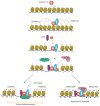Transcriptional and epigenetic networks of helper T and innate lymphoid cells
- PMID: 25123275
- PMCID: PMC4321863
- DOI: 10.1111/imr.12208
Transcriptional and epigenetic networks of helper T and innate lymphoid cells
Abstract
The discovery of the specification of CD4(+) helper T cells to discrete effector 'lineages' represented a watershed event in conceptualizing mechanisms of host defense and immunoregulation. However, our appreciation for the actual complexity of helper T-cell subsets continues unabated. Just as the Sami language of Scandinavia has 1000 different words for reindeer, immunologists recognize the range of fates available for a CD4(+) T cell is numerous and may be underestimated. Added to the crowded scene for helper T-cell subsets is the continuously growing family of innate lymphoid cells (ILCs), endowed with common effector responses and the previously defined 'master regulators' for CD4(+) helper T-cell subsets are also shared by ILC subsets. Within the context of this extraordinary complexity are concomitant advances in the understanding of transcriptomes and epigenomes. So what do terms like 'lineage commitment' and helper T-cell 'specification' mean in the early 21st century? How do we put all of this together in a coherent conceptual framework? It would be arrogant to assume that we have a sophisticated enough understanding to seriously answer these questions. Instead, we review the current status of the flexibility of helper T-cell responses in relation to their genetic regulatory networks and epigenetic landscapes. Recent data have provided major surprises as to what master regulators can or cannot do, how they interact with other transcription factors and impact global genome-wide changes, and how all these factors come together to influence helper cell function.
Keywords: ILCs; T cells; cell identity; epigenetics; gene regulation; transcription factors.
Published 2014. This article is a U.S. Government work and is in the public domain in the USA.
References
-
- Miller JF, Mitchell GF. The thymus and the precursors of antigen reactive cells. Nature. 1967;216:659–663. - PubMed
-
- Kisielow P, Hirst JA, Shiku H, Beverley PC, Hoffman MK, Boyse EA, Oettgen HF. Ly antigens as markers for functionally distinct subpopulations of thymus-derived lymphocytes of the mouse. Nature. 1975;253:219–220. - PubMed
-
- Shiku H, Kisielow P, Bean MA, Takahashi T, Boyse EA, Oettgen HF, Old LJ. Expression of T-cell differentiation antigens on effector cells in cell-mediated cytotoxicity in vitro. Evidence for functional heterogeneity related to the surface phenotype of T cells. J Exp Med. 1975;141:227–241. - PMC - PubMed
Publication types
MeSH terms
Grants and funding
LinkOut - more resources
Full Text Sources
Other Literature Sources
Research Materials




